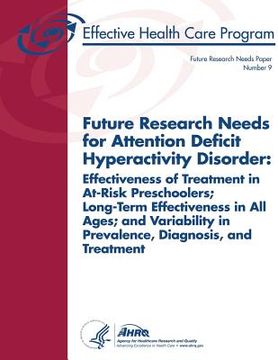Future Research Needs for Attention Deficit Hyperactivity Disorder: Effectiveness of Treatment in At-Risk Preschoolers, Long-Term Effectiveness in All (en Inglés)
Reseña del libro "Future Research Needs for Attention Deficit Hyperactivity Disorder: Effectiveness of Treatment in At-Risk Preschoolers, Long-Term Effectiveness in All (en Inglés)"
This Future Research Needs (FRN) report is based on a draft Agency for Healthcare Research and Quality (AHRQ) comparative effectiveness review, "Attention Deficit Hyperactivity Disorder: Effectiveness of Treatment in At-risk Preschoolers; Long-Term Effectiveness in All Ages; and Variability in Prevalence, Diagnosis, and Treatment." The Key Questions (KQs) were: KQ 1: Among children less than 6 years of age with Attention Deficit Hyperactivity Disorder or Disruptive Behavior Disorder, what are the effectiveness and adverse event outcomes following treatment? KQ 2: Among people ages 6 years or older with Attention Deficit Hyperactivity Disorder, what are the effectiveness and adverse event outcomes following 12 months or more of any combination of followup or treatment, including, but not limited to, 12 months or more of continuous treatment? KQ 3: How do (a) underlying prevalence of ADHD, and (b) rates of diagnosis (clinical identification) and treatment for ADHD vary by geography, time period, provider type, and sociodemographic characteristics? Findings in the draft review for KQ 1 supported the use of parent behavior training in preschoolers both for oppositional behaviors and for ADHD symptoms, with no adverse events reported. For preschoolers, psychostimulant medications are also generally safe and efficacious for improving behavior and can provide benefits in addition to parent training. However, adverse events, especially irritability and moodiness, can lead to discontinuation, and use for several months to a year slightly affects growth rate. For KQ 2, long-term effectiveness and safety studies of several psychostimulants in children over the age of 6 years and adolescents found they are efficacious for control of inattention and overactivity for extended periods of time. Few serious adverse events were noted. Publications from the Multimodal Treatment Study of Children with Attention Deficit Hyperactivity Disorder (MTA) study provide the best data for long-term outcomes. By 3 years, no single intervention group showed superior benefit, which is likely because of individuals obtaining a complex range of interventions in the community. The findings for KQ 3 included results from a systematic review and meta-regression that estimated the prevalence of ADHD among those ages 18 or younger at 5.29 percent, with more boys than girls identified and the highest rates of disorder occurring in 5- to 10-year-olds. Primary sources of variability were identified as methodological rather than geographic. Fewer studies are available that document prevalence in adult, adolescent, or preschool age groups. In this project, we worked with a group of stakeholders to refine 29 identified research gaps and transform them into eight highest-priority research needs in the field of ADHD. These highest-level needs included a broad range of issues cutting across age range (above and below 6 years of age), key clinical issues, and epidemiological and measurement concerns. Within this group of eight, clear themes emerged: the need for improved measurement tools, more generalizable study populations and settings, longer follow-up periods, more understanding of patient-level predictors of response, and more comparative evaluation of psychopharmacologic, psychosocial, and combination interventions across age ranges. PICOTS construction aided our consideration of study design issues and our sample power analyses demonstrated the clear pragmatic barriers that many of the potential designs will present. Advanced secondary data analysis methods may allow some of these complex questions to be addressed in a more cost effective manner but will not be able to fully replace the need for new large, long-term trials to evaluate these complex research needs in ADHD.

